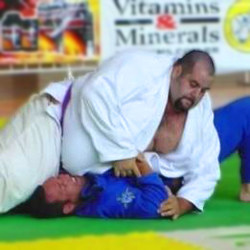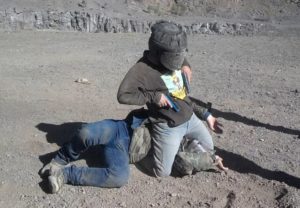
As someone who strongly advocates BJJ as a backbone art for a good base in self-defense, I am often asked what the benefits are. The obvious one is being able to fight well on the ground. However, BJJ goes far beyond that. One thing is does better than almost any other single activity is getting you mentally and emotionally prepared for the fight.
One of the biggest issues that can occur when you find yourself assaulted is that by definition, things are not going your way. Perhaps we let our situational awareness lapse, perhaps we did not realize that the person we were in range of was a violent criminal actor (VCA) because he was using a ruse, perhaps we happened to be injured or ill at the time of attack, or a myriad of reasons put us in a bad place. Regardless of how we got to that place, said place is going to be uncomfortable – physically, mentally, and emotionally. And, unfortunately, the typical gun-centric range training most of us engage in doesn’t do anything at all to prepare us for that level of pressure. It is just not possible to do so when there is not a living, breathing, resisting opponent who is determined to win and that we must lose.
One solution to this is what is called Force-on-Force training. Typically it uses marking cartridges such as Simunitions or UTM to have a pain penalty that is still safe. The gold standard for this type of training is Craig Douglas’ ECQC course (www.shivworks.com). This is terrifically useful and much needed, but there is a large drawback – it is hard to conduct such training more than once in awhile. Not only is it expensive to have guns that can use these cartridge’s, but the ammo is as well, and you also have to have good protective equipment like good helmets. It also can’t be conducted in too many places outside of a shooting range (while these rounds are not lethal, they do pack a punch and can damage surrounding structures and bystanders quite easily). And on top of all of that, it is incredibly demanding physically. A couple of hours of this kind of training will leave most people exhausted. Even for top athletes it would be tough to do more than on occasion.
However, the parts that are so valuable – the dealing with a resisting opponent and the physical, mental, and emotional pressures that are needed – can be more easily done in a BJJ academy. In every single moment you are on the mats there, you are going to be dealing with this type of situation. In a very short period of time, getting squashed underneath someone who outweighs you by 80 pounds becomes just another day. It does not exactly become ho hum, nor does it become comfortable. But it does help you lose the sense of dread and helplessness, and that feeling is something that stays with you no matter what, and that you will be able to draw on when you are being attacked for real. And the best part is that because the pressure can be adjusted in training, you can work like this hours at a time, day after day and be no worse for the wear.
I have said multiple times that BJJ gives the multi-disciplinary thinking tactician more bang for the buck than any other modality out there. Period. And getting comfortable with being uncomfortable is one of the, if not the single most useful.

